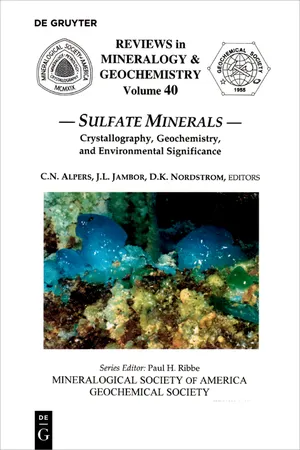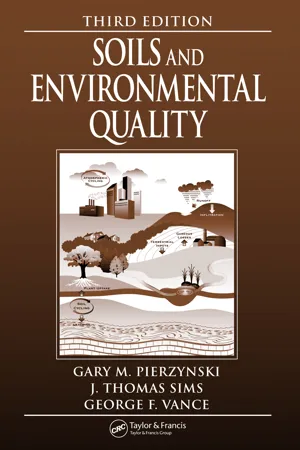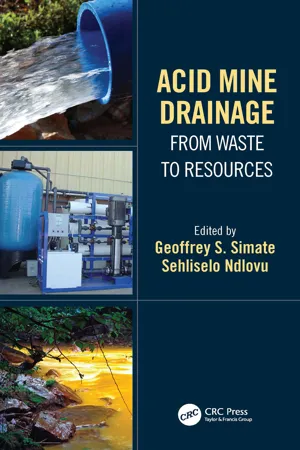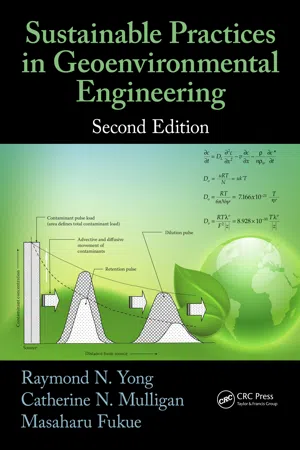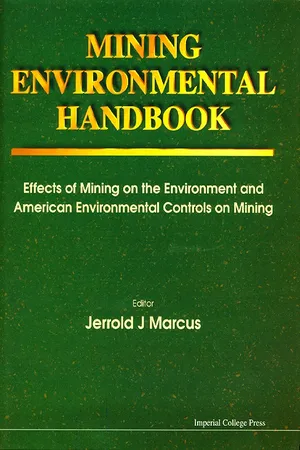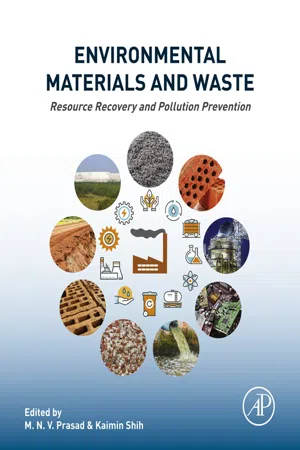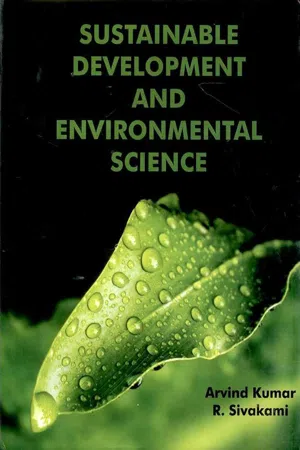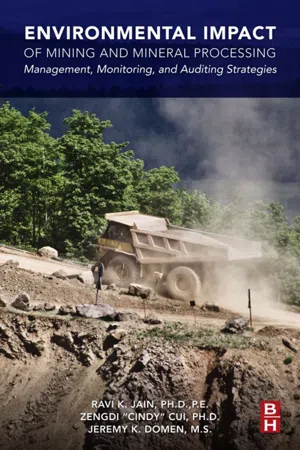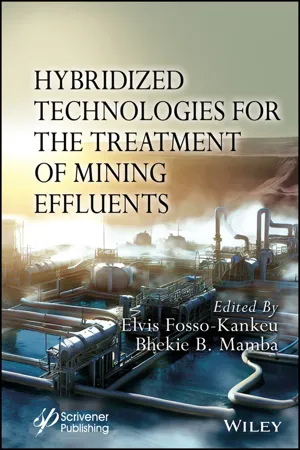Geography
Acid Mines
Acid mines refer to abandoned or active mining sites where the exposure of sulfide minerals to air and water leads to the formation of acidic runoff. This runoff, known as acid mine drainage, can contaminate water sources and harm aquatic life. Acid mines are a significant environmental concern, and remediation efforts often involve neutralizing the acidic runoff and preventing further contamination.
Written by Perlego with AI-assistance
Related key terms
1 of 5
12 Key excerpts on "Acid Mines"
- eBook - PDF
Sulfate Minerals
Crystallography, Geochemistry, and Environmental Significance
- Charles N. Alpers, John L. Jambor, D. Nordstrom, Charles N. Alpers, John L. Jambor, D. Nordstrom(Authors)
- 2018(Publication Date)
- De Gruyter(Publisher)
Much remains to be learned about their occurrence, formation, and properties. INTRODUCTION TO ACID SULFATE ENVIRONMENTS Mine drainage The best known examples of acid sulfate waters are those released from mines where coal and metallic sulfide ores have been exploited (Ash et al. 1951, Barton 1978, Nordstrom 1982a, Rose and Cravotta 1998, Nordstrom and Alpers 1999). There may be as many as 500,000 inactive or abandoned mine sites in the United States alone (Lyon et al. 1993). Although most of these pose no immediate water-quality problem, Kleinmami (1989) estimated that about 19,300 km of streams and more than 72,000 ha of lakes and reservoirs have been seriously damaged by mine effluents. Contamination of natural waters by mine drainage has killed enormous numbers of fish and other aquatic organisms, destroyed natural vegetation, induced massive erosion and sedimentation, caused widespread corrosion of bridge abutments, culverts, roads, and other structures, and made many streams and lakes so turbid as to be unfit for recreational activities. Most acid mine waters have pH values in the range of 2 to 4 (Nordstrom 1991, 1529-6466/00/0040-0007S05.00 DOI: 10.213 8/rmg. 2000.40.7 352 Bigham & Nordstrom Plumlee et al. 1999). Acid mine drainage occurs when acid production exceeds the buffering capacity of the host rock or the surrounding spoil and soil. In areas where carbonate rocks are available to neutralize acidity, higher pH drainage may be common. Cravotta et al. (1999), for example, reported a bimodal frequency distribution for the pH of a large number of mine drainage waters from the eastern U.S. coal province (Fig. 1). Most samples were either distinctly acidic (pH 2-4) or near neutral (pH 6-7), with relatively few samples having pH values in the range of 4 to 6. A similar distribution is apparent in the data of Plumlee et al. - eBook - PDF
- Gary M. Pierzynski, George F. Vance, Thomas J. Sims(Authors)
- 2005(Publication Date)
- CRC Press(Publisher)
The chemistry of the water is highly dependent on the chemistry of the overburden that was disturbed during the mining process. Acid mine drainage is another environmental concern due to the mining of minerals such as coal, Cu, Zn, uranium (U), and others. After exposure of overburden materials during the mining process, oxidation and leaching can produce drainage waters that are acidic and that contain harmful concentrations of dissolved minerals. Nationwide, numerous rivers, streams, lakes, and reservoirs have been adversely affected by contaminated water draining from abandoned mines. The vast majority of these problem areas occur in the eastern United States where coal mine drainage is considered by the U.S. EPA to be the most significant nonpoint pollution problem. Wyoming is currently the leading coal-producing state in the country supplying approximately 40% of our nation’s annual production, which is primarily due to the low S content of its coal and ease of extraction. Wyoming and other western states are also plagued with historic mining activities (e.g., mining that occurred in the 1800s) involving metal ores such as Cu, Pb, Zn, silver (Ag), and with the trace elements molybdenum (Mo) and U that were mined in certain regions. - eBook - ePub
Acid Mine Drainage
From Waste to Resources
- Geoffrey S. Simate, Sehliselo Ndlovu, Geoffrey S. Simate, Sehliselo Ndlovu(Authors)
- 2021(Publication Date)
- CRC Press(Publisher)
Despite many socio-economic benefits, the legacy of mining is mostly associated with many environmental impacts such as land degradation, solid waste disposal challenges, biodiversity loss, AMD, air and water pollution. This chapter focuses on the problem of AMD at mine sites and gives a critical review of its management through prediction. It is evident that mining, quarrying, excavation and mineral beneficiation activities to recover mineral-based products such as base metals, uranium, precious metals, coal and industrial minerals often expose sulphidic materials to the outside environment with the potential to form AMD (Rae et al., 2007). As part of EIA process, it is now a regulatory requirement for mine owners in most countries to predict the AMD potential for all types of mineral wastes and prepare management plans for future mitigation and to protect the environment at all stages of the mine life cycle (Maest et al., 2005; Price, 2009; Elaw, 2010).The issue of AMD at mine sites has been a challenging environmental problem for many years. It is known to have contaminated soils, polluted water, affected ecosystems and destroyed biological resources (Banks et al., 1997; Bell et al., 2001; Gordon, 1994; Gray, 1997). Rae et al. (2007) classify AMD discharge as either acidic, neutral or saline (alkaline). Although the environmental impacts of acidic drainage are well known, the neutral and alkaline drainages may also be harmful and difficult to manage if they are metalliferous in nature, that is, if they contain elevated levels of dissolved metal ions. However, alkaline drainage is rare relative to acidic or metalliferous drainage (Rae et al., 2007; Price, 2009).In the past, mining firms managed AMD problems by developing remediation plans only after its occurrence and subsequent impacts. The consequences of this reactive approach were extensive damage to natural resources and huge remediation costs. It was later realised that the practice was uneconomic and environmentally unacceptable, and so, the mining sector changed and started to focus more on proactive mitigation measures based on accurate prediction of drainage chemistry to prevent AMD formation and its impact (USEPA, 1994; Price, 2009). Furthermore, the interests for early assessment and detection for potential of mineral waste materials to generate acid using various prediction methods arose out of concerns of lag times associated with the occurrence of AMD and the costly lessons learnt from its long-term (perpetual) care over the years (USEPA, 1994; Price, 2009). In addition, the prediction of drainage chemistry was driven by the legal requirements in many countries such as the United States, Australia, Canada, etc., which stipulated that mining permits would only be granted if applicants included plans with practical methods to avoid AMD (USEPA, 1994; Price, 2009). This requirement led to increased efforts to develop techniques to predict the drainage chemistry and understand methods to avoid pollution (Lawrence et al., 1989; Ridge and Seif, 1998). - No longer available |Learn more
- Raymond N. Yong, Catherine N. Mulligan, Masaharu Fukue(Authors)
- 2014(Publication Date)
- CRC Press(Publisher)
There are countless documents reporting on the various studies and efforts in “curing the problem,” and the reader is advised to consult these for detailed elaboration of the various research and case studies undertaken (and also presently under-way). For the discussion that follows, only the basic elements of the mitigating efforts will be addressed. The phenomenon of acid generation from heaps with trace amounts of sulfide minerals and from exposed sulfide minerals in mined-out caverns, pits, etc., has been discussed in Section 5.2. The magnitude of the sets of cascading problems attributed to the actions of acid leachate cannot be overstated. Cleanup of all the affected areas, mining sites, water-ways, etc., is estimated in the billions of dollars in North America. Not only is the threat expressed in terms of acid leachates finding their way onto the land environment and into receiving waters, but also in terms of release of trace metals into the geoenvironment. The leachates and released metals will negatively affect the functionality of the various ecosys-tems that comprise the geoenvironment—causing them to be eventually unsustainable. In terms of sustainable land use, the obvious protection against such stressors (acid leach-ates) is to remove conditions and circumstances favorable for generation of acid leachates through source control. This means denying access to oxygen and water. The principle of “keep it dry” is a good principle to practice at mine sites. This is an easy statement to make, but is in reality a very difficult and an almost impossible principle to adhere to. Since water is an essential element in mining–extraction processes, “keeping it dry” 165 Natural Resources Extraction requires one to provide protective covers, isolation barriers, and pump–discharge opera-tions. Implementation of these techniques is dependent on site- and operation-specific conditions. - eBook - PDF
Mining Environmental Handbook: Effects Of Mining On The Environment And American Environmental Controls On Mining
Effects of Mining on the Environment and American Environmental Controls on Mining
- Jerrold J Marcus(Author)
- 1997(Publication Date)
- ICP(Publisher)
Chapter 13 ACID MINE DRAINAGE AND OTHER MINING-INFLUENCED WATERS (MIW) edited by R. L. Schmiermund and M. A. Drozd 13.1 INTRODUCTION by R. L. Schmiermund The origins of the phrase Acid Mine Drainage (AMD) are obscure but it was probably first used to describe the low-pH effluent from certain underground mine workings. In view of its common use today as a descriptive phrase applied to most types of mining-influenced waters, the term is inadequate due to its limited scope and consequently is often misleading. The more recent modification, acid rock drainage (ARD), de-emphasizes the obvious genetic relationship of mining to the vast majority of such waters but is unfortunately no more inclusive than its predecessor. The objective of this chapter is to provide an overview of the characteristics of natural waters affected by mining activities (exclusive of direct contributions and discharges from milling and other beneficiation operations) and to briefly discuss the geochemical processes relevant to those characteristics. Such waters include groundwaters that enter underground workings and exit via surface openings or are pumped to the surface, groundwaters that enter pits or surface excavations and contribute to surface water courses, meteoric precipitation which, in the course of becoming runoff or recharge to surface water bodies, contacts pit faces, ore and waste-rock piles or tailings piles. Many such waters are indeed acidic with pHs significantly less than 7.0, thus giving legitimacy to the term AMD. The fact that all these generic rock-water interactions may also take place, with similar impacts to water quality, in the absence of mining validates the term ARD. Indeed, situations occur where ore bodies naturally outcrop at the surface and are actively weathering and impacting surface water courses. One such example is the Vangorda base-metal massive sulfide orebody near Faro, Yukon Territories. Others are described by Runnells et al. (1992) and Plumlee et al. - eBook - PDF
- Er Sunil Kumar(Author)
- 2010(Publication Date)
- IntechOpen(Publisher)
Sulfide oxidation is mainly controlled by oxygen and water flux, type of sulfide minerals, type of neutralizing minerals, and the microbial activity. The relation of acid producing processes and neutralizing processes determinates the geochemical Eh-pH conditions and so the mobility of the liberated elements. Thus, it is crucial to determinate the acid producing minerals (primary and secondary) and the acid neutralizing minerals in mine waste in order to predict future geochemical behaviour and the hazardous potential of the material. Summarizing, it can be stated that for accurate mine waste management assessment, a combination of detailed mineralogical, geochemical, and microbiological studies has to be performed in order to understand and predict the complex geomicrobiological interactions in acid rock drainage formation. 4. References Acker, J.G. and Bricker, O.P., 1992. The influence of pH on biotite dissolution and alteration kinetics at low temperature. Geochimica et Cosmochimica Acta, 56: 3073-3092. Basic Concepts in Environmental Geochemistry of Sulfidic Mine-Waste Management 193 Ahonen, L. and Tuovinen, O.L., 1994. Solid-Phase Alteration and Iron Transformation in Column Bioleaching of a Complex Sulfide Ore. In: C.N. Alpers and D.W. Blowes (Editors), Environmental Geochimistry of Sulfide Oxidation. ACS Symposium Series, Washington, pp. 79-89. Alpers, C.N., Blowes, D.W., Nordstrom, D.K. and Jambor, J.L., 1994. Secondary minerals and acid mine-water chemistry. In: J.L. Jambor and D.W. Blowes (Editors), Short course handbook on environmental geochemistry of sulfide mine-waste. Mineralogical Association of Canada, Nepean, pp. 247-270. Banfield, J.F. and Nealson, K.H. (Editors), 1997. Geomicrobiology. Reviews in Mineralogy, 35. MSA, Washington, DC, 448 pp. Barker, W.W., Welch, S.A., Chu, S. and Banfield, J.F., 1998. Experimental observations of the effects of bacteria on aluminosilicate weathering. - eBook - ePub
Environmental Materials and Waste
Resource Recovery and Pollution Prevention
- Majeti Narasimha Vara Prasad, Kaimin Shih(Authors)
- 2016(Publication Date)
- Academic Press(Publisher)
Water, Air, and Soil Pollution. 2006;173:121–149.Sánchez España J, López Pamo E, Santofimia Pastor E, Reyes Andrés J, Martín Rubí J.A. The removal of dissolved metals by hydroxysulphate precipitates during oxidation and neutralization of acid mine waters, Iberian Pyrite Belt. Aquatic Geochemistry. 2006;12:269–298.Sangita, Udayabhanu G, Prasad B. Studies on environmental impact of acid mine drainage generation and its treatment: an appraisal. Indian Journal of Environmental Protection. 2010;30(11):953–967.Santisteban M, Grande J.A, de la Torre M.L, Valente T, Ceron J.C. Acid mine drainage in semi-arid regions: the extent of the problem in the waters of reservoirs in the Iberian Pyrite Belt (SW Spain). Hydrology Research. 2015;46(1):156–167.Sapsford D, Santonastaso M, Thorn P, Kershaw S. Conversion of coal mine drainage ochre to water treatment reagent: production, characterisation and application for P and Zn removal. Journal of Environmental Management. 2015;160:7–15.Sarmiento A.M, Olías M, Nieto J.M, Cánovas C.R, Delgado J. Natural attenuation processes in two water reservoirs receiving acid mine drainage. Science of the Total Environment. 2009;407(6):2051–2062.Sasaki K. Effect of grinding on the rate of oxidation of pyrite by oxygen in acid solutions. Geochimica et Cosmochimica Acta. 1994;58(21):4649–4655.Sasaki K, Nukina S, Wilopo W, Hirajima T. Removal of arsenate in acid mine drainage by a permeable reactive barrier bearing granulated blast furnace slag: column study. Materials Transactions - Luis Felipe Mazadiego, Eduardo De Miguel Garcia, Fernando Barrio-Parra, Miguel Izquierdo-Díaz, Luis Felipe Mazadiego, Eduardo De Miguel Garcia, Fernando Barrio-Parra, Miguel Izquierdo-Díaz(Authors)
- 2020(Publication Date)
- IntechOpen(Publisher)
85 Chapter 6 Geoenvironmental Characterization of Sulfide Mine Tailings Tomás Martín-Crespo, David Gómez-Ortiz and Silvia Martín-Velázquez Abstract Spain has a long mining tradition dating from pre-historic times up to the present day. The cessation of mining activity has generated a large amount of mine wastes, most of which represent geochemical hazards. Mine tailings are watery sludge composed of medium-to-fine-grained material, resulting from grind-ing and mineral processing (e.g., galena, pyrite, sphalerite, and arsenopyrite). They entail both an accumulation and a potential subsequent emission source of trace elements (i.e. As, Cu, Fe, Pb, and Zn) with formation of acid mine drainage (AMD). Mineralogical and geochemical techniques (in combination with geophysi-cal surveys and aerial photographs studies) have been jointly applied to selected mine areas. Seven mine deposits from the most important mine districts in Spain have been selected: Iberian Pyrite Belt, Cartagena-La Unión, Alcudia Valley, and Mazarrón. The main goal is focused on getting a geoenvironmental characterization as complete as possible by determining the geometry, evolution in time and compo-sition of mine ponds, and the possible occurrence of AMD, for identifying related environmental hazards. Keywords: mine tailings, mineralogy, geochemistry, geoenvironmental, Spain 1. Introduction Sulfide ore minerals are generally concentrated by milling and flotation, which produces tailings containing gangue minerals and residual sulfides. Milling involves crushing and grinding to reduce particle size and liberate ore minerals from the rock matrix. After ore minerals have been extracted and concentrated, the resulting tailings are commonly dewatered and deposited in sub-aerial tailings, impound-ments, or stockpiles [1]. They are piled up as less than 5 cm thick layers and are slightly differentiated by compositional and/or granulometric features.- eBook - ePub
- Ram Naresh Bharagava(Author)
- 2018(Publication Date)
- CRC Press(Publisher)
AMD also results from outflow of acidic water from thousands of abandoned mines sites and mineral wastes and occurs naturally within environments containing an abundance of sulfide minerals and microbial activity. This results in high acidity and high dissolved-metal concentration in mine drainage, which has adverse effects on aquatic ecosystems of the receiving rivers, corrosion of machinery in mines, and other environmental problems (Berghorn and Hunzeker 2001; Gaikwad and Gupta 2007; Hema et al. 2003; Rawat and Singh 1982). AMD is not only associated with surface water and groundwater pollution, but it is also responsible for the degradation of soil quality and aquatic habitats and for leaching of heavy metals into groundwater (Adler and Rascher 2007). The amount of AMD produced depends on the size of the exposed surface area of sulfide minerals. The concentration of dissolved metal ions in AMD also depends on the type and quantity of sulfide minerals present, as well as the host rock composition (Hema et al. 2003; Ziemkiewcz et al. 2003).The AMD problem is severe in metal mining areas, such as the Iberian Pyrite Belt in the southwest of Spain, the largest sulfide deposit in the world (Olias et al. 2004). In India, the coal mines that face a serious pollution problem due to AMD are Baragolai (ECL); Churcha, West Chirimiri, Ambora, Chandameta and Rkhikol (WCL); Gorbi (NCL) and Margarita group of mines; and Assam (NECL) (Jamal et al. 1991; Rawat and Singh 1982). Tertiary coal of NECL contains as high as 8% sulfur with different percentages of pyrite, sulfate, and organic and free sulfur. Acid drainage due to overburden near this coalfield is a serious environmental problem due to low pH and high sulfate, total dissolved solids (TDS), and iron of the mine water (Tiwary 2001).4.2Chemistry of Acid Mine Drainage GenerationThe weathering of sulfide minerals accounts for most of the surface water and groundwater contamination that result from mining activities. Pyrite, the most ubiquitous sulfide mineral, is principally responsible for acid discharges from underground coal and metal mines, surface mine spoils, and tailing disposal areas (Hammack et al. 1988). In the oxidation of iron sulfide, pyrite is the primary mechanism by which the acid is released into mine drainage (Abbassi et al. 2009; Akcil and Koldas 2006; Banks et al. 1997; Gaikwad and Gupta 2007; Gray 1997; Neculita et al. 2007). The process is initiated by the breakdown of pyrite in the presence of oxygen and water to yield ferrous iron, sulfate, and acidity (Singer and Stumm 1970): - Kumar, Arvind(Authors)
- 2021(Publication Date)
- Daya Publishing House(Publisher)
All the non-scientitic activities lead to the formation of mined wastelands and virtually become the foci of desertification during and after the mining operation (Mann and Chatterji, 1978). Mine spoils are defined here as the waste materials generated by the grinding and processing of ores and other materials containing economically retrievable minerals. Many processing method involve grinding of rock and ores, chemical and or physical removal of the desired commodity and transportation of the wastes, often as slurry, to a tailings or retention pond. These impoundments may range from a few to thousands of hectares in size. More than 99 per cent of the original material may finally become tailings when utilizing low quality ores (Gemmell, 1977). Disturbed land resulting from both surface and underground mining can result in major water quality problems as well as being unsightly and unproductive. Besides coal, sand, gravel, stone, clay, copper, iron ore, phosphate rock, and other minerals account for most of the mining. Abandoned mine tailings have extremely diverse physical, chemical and ecological conditions (Berg et al., 1975; Gemmell, 1973; Hunter and and Whiteman, 1974; Ludeke, 1977; Shamshuddin et al., 1986). The mine spoils am normally variable in physical composition particularly nitrogen, phosphorus and potassium. Acid drainage due to sulfide oxidation may be a consideration. Some mine spoils may have elevated levels of heavy metals or other toxic materials (Whiteby and Hutchinson, 1974; Hutchinson and Whitby, 1974). Plant uptake of potentially toxic chemicals or heavy metals and their incorporation into the food chain are real concerns. Considering the ill-effects of mine spoils Government of India has framed some environment–related rules to be followed by the mine This ebook is exclusively for this university only. Cannot be resold/distributed.- eBook - ePub
Environmental Impact of Mining and Mineral Processing
Management, Monitoring, and Auditing Strategies
- Ravi Jain(Author)
- 2015(Publication Date)
- Butterworth-Heinemann(Publisher)
Chapter 4Environmental Impacts of Mining
Abstract
Due to the worldwide increase in mineral production, it is important that environmental impacts from mining and mineral processing be properly assessed. This chapter covers the impacts of mining and mineral processing relating to six areas of concern: air quality, water quality and quantity, acid mine drainage, ecological impacts, land impacts, and economic impacts. All the areas of concern are closely related, as air, water, and land impacts almost always have significant impacts on the local ecology and can significantly impact human health and the local economy. Understanding these negative impacts, their sources, and environmental and ecological implications is necessary if mining and mineral processing is to become more sustainable.Keywords
Air quality; Water quality; Acid mine drainage; Land impacts; Particulate emissions; Economic impacts; Ecological impacts; Human health impacts4.1. Introduction
The environmental characteristics, or attributes, defined and described in this chapter represent a selected set of elements designed to be used in the environmental assessment process for mining and mineral processing. These attributes may be applicable for certain mining situations, but may not be all inclusive. Environmental attributes should be adapted to each specific mining situation. Five primary environmental areas of concern were selected relating to mining and mineral processing, with a sixth, economics, selected as a discussion topic as mining is closely tied with the economy of a country. They are:• Air quality • Water quality/quantity • Acid mine drainage • Land impacts • Ecological impacts • Economic impacts In reality, all six areas are closely tied to one another and it can become difficult to separate one from the other.Passage contains an image
4.2. Air Quality Impacts from Mining
Air emissions from mining can affect not only the surrounding areas, but can affect regional and global air quality. Air quality can generally be defined as the measure of ambient atmospheric pollution relative to the potential to inflict environmental harm or to adversely affect human health. Air quality is highly vulnerable because unlike water or other wastes, air cannot, in practice, be reprocessed at some central location and subsequently distributed for reuse (Jain et al., 2012 - Elvis Fosso-Kankeu, Bhekie B. Mamba(Authors)
- 2023(Publication Date)
- Wiley-Scrivener(Publisher)
EARTHWORKS, p. 228, 2006, [Online]. Available: http://www.earthworksaction.org/library/detail/predicting_water_quality_ problems_at_hardrock_mines_–_an_earthworks_white_/#.VRV8u-HlS6R. 34. Edwards, K.J., Bond, P.L., Druschel, G.K., McGuire, M.M., Hamers, R.J., Banfield, J.F., Geochemical and biological aspects of sulfide mineral dissolu- tion: Lessons from Iron Mountain, California. Chem. Geol., 169, 3–4, 383– 397, 2000. 35. Duggan, L.A., Wildeman, T.R., Updegraff, D.M., The aerobic removal of manganese from mine drainage by an algal mixture containing cladophora. J. Am. Soc. Min. Reclam., 1992, 1, 241–248, 1992. 36. Konasewich, D., Jones, C., Morin, K., Gerencher, E., Hydrological assessment and development of AMD control technology for Myra Falls waste rock, in: 14th Proceedings of Annual British Columbia Mine Reclamation Symposium, Cranbrook, BC, 1990. 37. Kleinmann, R.L.P. and Erickson, P.M., Control of acid drainage from coal refuse using anionic surfactants. Report of Investigations - United States, Bureau of Mines, 1983. 38. Watzlaf, G.R., Control of acid drainage from mine wastes using bacterial inhibitors. J. Am. Soc. Min. Reclam., 1986, 1, 123–130, 1986. 39. Younger, P.L. and Sapsford, D.J., Acid drainage prevention guidelines for Scottish opencast coal mining: The primacy of the conceptual model. 7th International Conference on Acid Rock Drainage 2006, ICARD - Also Serves as the 23rd Annual Meetings of the American Society of Mining and Reclamation, October 2014, vol. 3, pp. 2558–2570, 2006. 40. Trumm, D., Selection of active and passive treatment systems for AMD— Flow charts for New Zealand conditions. New Zealand J. Geol. Geophys., 53, 2–3, 195–210, 2010. 41. Simmons, J.A. et al., Small-scale chemical changes caused by in-stream lime- stone sand additions to streams.
Index pages curate the most relevant extracts from our library of academic textbooks. They’ve been created using an in-house natural language model (NLM), each adding context and meaning to key research topics.
